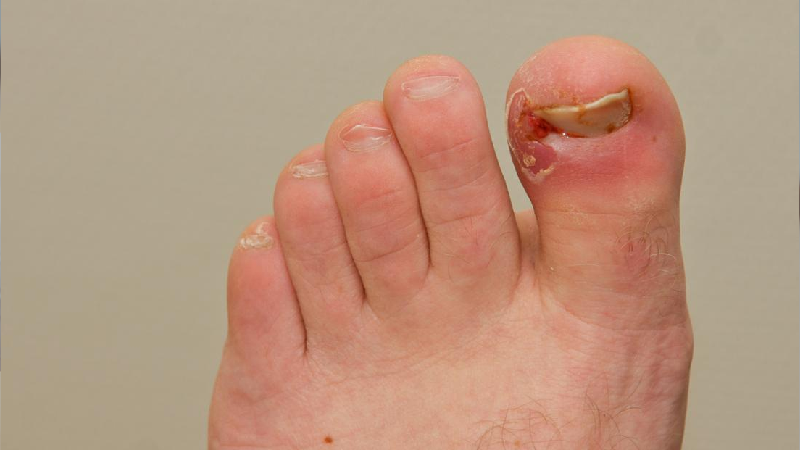Ingrowing Toe Nail —– Dermatologist Domain
What is an Ingrown Toenail:
An ingrown toenail (onychocryptosis) occurs when part of the nail penetrates the skin, which can often result in an infection. The ingrown nail can also apply pressure in the nail fold area without penetrating the skin – this is not technically an ingrown toe nail, but can also be painful (a corn/callus is also common down the side of the nail and is a reaction to this pressure, rather than the nail actually penetrating the skin).
What does an ingrown toe nail (onychocryptosis) look like:
Usually the side of the nail penetrates deep and it is difficult to see the edge of the nail. The severity of appearance of the nail will vary. Some will just have a nail that appears deeply embedded down the side or sides of the nail. In some the corner or a small spike of nail may penetrate the skin, just like a knife. This can result in an infection and the development of proud flesh (granulation tissue). The toe will then be red, inflamed and painful.
What are the symptoms of in ingrown toenail (onychocryptosis):
Pain is the main symptom of an ingrown toe nail – usually just starting as some minor discomfort. This may be just the pressure from the side of the nail or it may be because the nail has actually penetrated the skin down the side of the nail. The toe is not necessarily infected, but this can develop after the nail penetrate the skin to become ingrown. The infection can spread, making the toe red and inflamed (paronychia). A collection of pus may also develop.
What causes an ingrown nail (onychocryptosis):
Poor cutting of the nail is most commonly blamed as being the cause of an ingrown toe nail, but this is not necessarily the case.
The following factors are involved in the cause of ingrown toenails (onychocryptosis):
- The primary risk factor is the shape of the nail – a nail that is more curved from side to side rather than being flat is more likely to become an ingrown nail (incurvated nails). Some nails go down the side into the nail fold area for a relatively large distance. A large portion of the nail is almost vertical rather than being horizontal. The most severe of these types of nail is called a ‘pincer nail’ in which both side of the nail are very curved. The shape of the nail is usually inherited (congenital), but it can be influenced by trauma and/or shoe pressure.
- Poor cutting of these types of nails can leave a sharp corner (or if worse, a small spike) that will initially cause symptoms by putting pressure on the skin and then later penetrate the skin. Trimming too far down the sides is a common cause of an ingrown toe nail.
- Footwear that is tighter is more likely to increase pressure between the skin in the nail fold and nail, increasing the risk on an ingrown nail.
- Previous trauma to the nail may alter the shape of the nail, making it more prone to becoming an ingrown nail
- Pressure from the toe next to the nail that has ingrown can sometime be a factor
- A ‘chubby’ or fleshy toe is more likely to have a nail grow into it. Those whose feet swell are a lot are more prone to having this happen.
Treatment of the Ingrown Nail (onychocryptosis):
The cornerstone of treatment and prevention of ingrown toe nails involves cutting the nail straight across to allow the corners to protrude, so that they do not penetrate the skin. Cut the toe nails straight across without tapering the corners. However, this can be difficult if the nail is very curved down the side. In this case DO NOT ‘dig’ down the sides – seek DERMATOLOGIST help for this .
- Avoid wearing shoes and socks that are too tight.
- Keep feet clean to prevent the ingrown nail from becoming infected.
Those with poor circulation or diabetes should not do any self management of ingrown toenails but see a Dermatologist.
Other modalities of therapy –
MEDICAL TREATMENT
SURGICAL TREATMENT – NAIL SPLINTING
I URGE ALL THE PATIENTS OF INGROWING TOE NAIL TO CONTACT AN EXPERT DERMATOLOGIST FOR THEIR PROBLEM AND DO NOT GO TO SHOE SHOWROOMS FOR TREATMENT OF THIS PROBLEM TO AVOID FURTHER AGGRAVATION OF THIS PROBLEM.
